In just one week of cold weather gripping Gaza, six babies across the enclave have died of hypothermia.
As Israel continues its attacks on Gaza and its hospitals, its restrictions on who can enter the Palestinian territory mean that access to winter aid and medical intervention also remains limited. Israel’s war in Gaza has killed more than 45,500 people, most of them children and women.
Here’s what you need to know about the condition that has killed several babies and threatens a population of 2.3 million people, most of whom have been displaced from their homes and are surviving in the bitter cold with insufficient food and drinking water.
What is hypothermia?
Hypothermia, which literally means below normal heat, is a condition that occurs when the body loses heat faster than it can produce it.
The body normally maintains a fixed, warm core temperature of about 37 degrees Celsius (98.6 degrees Fahrenheit) using various mechanisms, such as metabolic heat production, which involves digesting food or moving muscles.
Core temperature should be maintained at approximately this level, between a narrow range of 36.1C (97F) and 37.2C (99F), depending on the individual, time of day, and activity level. This allows vital organs, such as the brain and heart, to continue to function properly.
However, when the body can no longer compensate for heat loss and internal temperatures drop dangerously low, the body enters a state of hypothermia.
At what temperature do you have hypothermia?
Hypothermia depends on the body’s core temperature rather than the external temperature, as you can develop it even in milder cold conditions, not just freezing conditions.
A person can develop hypothermia even in temperatures above 4C (40F) if chilled by rain, wind or immersion in cold water.
Medically speaking, hypothermia begins when the body’s core temperature drops below 35 C (95 F), roughly two degrees below its average.
The severity of the condition depends on how low the internal temperature drops:
- Mild hypothermia: 32–35C (89.6–95F)
- Moderate hypothermia: 28–32C (82.4–89.6F)
- Severe hypothermia: below 28C (82.4F)
What are its signs and symptoms?
What happens to the body depends on the severity and stage of hypothermia.
During initial cold exposure, the body begins to lose heat through the skin. Wind or water accelerates this process by removing the thin layer of warmth around the body.
To conserve heat, blood vessels in the skin constrict, reducing blood flow to the surface. This keeps more heat near the vital organs, but makes the fingers, feet and other limbs feel cold and numb.
To generate more heat, the body begins to shiver, and breathing and heart rate increase to pump warm blood to vital organs and support metabolism.
However, mild confusion, clumsiness, and fatigue may occur as the cold begins to affect the brain and muscles.
As cold exposure continues, heat loss exceeds the body’s internal efforts to generate heat, and moderate hypothermia begins. The shaking stops as the muscles run out of energy, and a feedback loop makes the situation worse: as the metabolism slows down, the body produces even less heat.
Heart rate, breathing and metabolic processes slow further as the body tries to conserve energy. As this vicious circle continues, the gap between heat lost and heat produced widens.
Eventually, the drop in internal temperature becomes severe.
The brain’s ability to function deteriorates, leading to unconsciousness. The cold disrupts the heart’s electrical system, causing irregular rhythms that can lead to cardiac arrest.
Without prompt medical intervention, vital functions may fail completely, resulting in death.

Can hypothermia be stopped?
Yes, hypothermia can be stopped if steps are taken in time.
Recovery from moderate to mild hypothermia involves moving the person to a warm, dry environment, removing any wet clothing, and covering them with blankets to warm the body.
Warm, non-alcoholic drinks may help if the person is conscious.
Severe hypothermia, however, often requires medical intervention. This includes passive rewarming with warm blankets, or active rewarming techniques, such as administering warm intravenous fluids or rewarming the blood.
Blood rewarming involves removing blood from the body, usually through a large catheter, warming it with a specialized machine, and re-infusing it into the body.
Are babies most at risk of hypothermia?
Babies face a higher risk as their bodies lose heat faster than adults.
This is because their bodies have different shapes. Compared to adults, they have more skin (surface area) for their size (body mass). This means they lose heat more quickly through their skin, especially in cold environments. Since their small bodies cannot produce heat as efficiently as adults, they are at a higher risk of getting too cold.
They may also not show obvious signs of cold stress, making hypothermia more difficult to recognize.
Severe malnutrition also increases the risks of hypothermia. Restrictions on food and medicine entering Gaza, since the war began on October 7, 2023, mean the enclave has been experiencing famine-like conditions for a year.

What are the current temperatures in Gaza?
In the last week of December 2024, temperatures ranged from around 19C to 20C (66F to 68F) and overnight lows between 11C and 12C (52F and 54F)
However, the current winter in Gaza is harsh for those living in tents or without proper shelter, as heavy rains and strong winds have destroyed temporary coverings, clothing and soaked blankets.
With limited access to fuel, electricity or gas heaters due to severe restrictions imposed by Israel, many residents resort to cutting down trees for firewood to stay warm and cook.
How cold is it in Gaza and does it snow?
During the winter months, particularly in January, average low temperatures can drop to around 9C (45F), with daytime highs near 18C (65F).
Although winters in the enclave are not extremely harsh, heavy rains and its coastal location can make it feel cooler. December and January are also the wettest months in Gaza.
It does not usually snow in Gaza, but rare cases of snow have been reported in the past, such as in December 2013.



